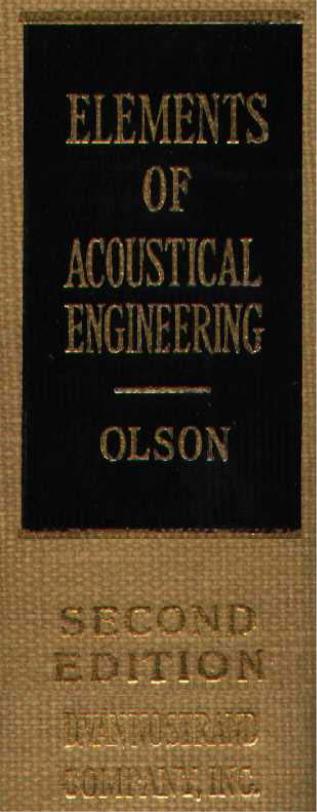
- •Preface
- •II. ACOUSTICAL RADIATING SYSTEMS
- •III. MECHANICAL VIBRATING SYSTEMS
- •IV. DYNAMICAL ANALOGIES
- •V. ACOUSTICAL ELEMENTS
- •VI. DIRECT RADIATOR LOUDSPEAKERS
- •VII. HORN LOUDSPEAKERS
- •VIII. MICROPHONES
- •IX. MISCELLANEOUS TRANSDUCERS
- •1. Variable area
- •XI. ARCHITECTURAL ACOUSTICS AND THE COLLECTION AND DISPERSION OF SOUND
- •12.7. Loudness
- •XIII. COMPLETE SOUND REPRODUCING SYSTEMS
- •13.4. Telephone
- •XIV. MEANS FOR THE COMMUNICATION OF INFORMATION
- •XV. UNDERWATER SOUND
- •XVI. ULTRASONICS


1
D. VAN NOSTRAND COMPANY, INC.
120 Alexander St., Princeton, New Jersey (Principal office)
24 West 40 Street, New York 18, New York
D. VAN NOSTRAND COMPANY, LTD.
358, Kensington High Street, London, W.14, England
D. VAN NOSTRAND COMPANY (Canada) LTD.
25 Hollinger Road, Toronto 16, Canada
COPYRIGHT ©1957, BY
D. VAN NOSTRAND COMPANY, INC.
Library of Congress Catalogue Card No. 57-8143
Published simultaneously in Canada by
D. VAN NOSTRAND COMPANY (Canada), LTD.
No |
reproduction |
in any form |
of |
this book, in whole or in |
part |
(crcept for |
brief quotation |
in |
critical articles or reviews). |
may be made without written authorization from the publishers.
This book is based on an earlier work entitled Elements of Acoustical Engineering, by Harry F. Olson, copy right 1940, 1947 by D. Van Nostrand Company, Inc.
First Published May 1957
Reprinted August 1960
PRINTED IN THE UNITED STATES OF AMERICA
PREFACE
The first edition of this book, published in 1940, was the subject matter of thirty lectures prepared for presentation at Columbia University. It was an exposition of the fundamental principles used in modern acoustics and a description of existing acoustical instruments and systems.
Many and varied advances were made in acoustical engineering in the seven years following the issuance of the first edition. The second edition of the book, published in 1947, covered the advances in acoustics which were made in the period between the first and second editions. Since the publication of the second edition, the developments in acoustics have been on an ever greater scale than in the period between the first and second edi tions. Today, the science of acoustics includes the generation, transmission, reception, absorption, conversion, detection, reproduction and control of sound. An important division of acoustical engineering is sound repro duction as exemplified by the telephone, radio, phonograph, sound motion picture and television. These sound reproducing systems are universally employed in all variations of modern living. The impact of the reproduc tion of sound by these systems upon the dissemination of information, art and culture has been tremendous.
The ultimate useful destination of all informative sound, direct or repro duced, is the human ear. In this connection, great strides have been made in obtaining knowledge on the characteristics and action of the human hear ing machine. Measurements play an essential part in the advancement of any scientific field. Instruments have been developed and standards have been established for the measurement of the fundamental quantities in acoustics. The applications of acoustics in the field of music have led to a better understanding of the stuff of which music is made. This knowledge has been applied to the development of new musical instruments employing the latest electronic and acoustical principles.
Accelerated by the requirements in W orId War II, tremendous advances were made in underwater sound. The developments in underwater sound have resulted in systems for detection and accurate location of underwater craft and obstacles over great distances, depth sounders and other acoustic applications in undersea communication. The industrial applications of ultrasonics have unfolded a new field in acoustics. Some of the important ultrasonic developments include the cleaning of machine parts, drilling and flaw detection. The science of architectural acoustics has advanced to the point where auditoriums, studios and rooms can be designed to obtain ex cellent acoustics under severe artistic conditions. With ever increasing in-
iii
11
IV |
PREFACE |
dustrial expansion comes an increase in noise. Work is now under way actively to control noise by the use of a variety of acoustic countermeasures.
The preceding brief description of the present status of acoustics shows that it plays a very important part in our modern civilization. Furthermore, the fundamentals and applications of the science of acoustics are so well formulated and substantiated that a large area of the field of acoustics has attained an engineering status. In preparing new material and in revising existing material in the third edition, the same principles were followed as in the first and second editions. Particular efforts have been directed towards the development of analogies between electrical, mechanical and acoustical systems because engineers have found that the reduction of a vibrating system to the analogous electrical network is a valuable tool in the analysis of vibrating systems. Each chapter has been brought up to date and ampli fied. Two new chapters on Complete Sound Reproducing Systems and
.Yfeans for the Communication of Information have been added. As in the first and second editions most of the illustrations contain several parts so that a complete theme is depicted in a single illustration.
The author wishes to express his appreciation to Miss Patricia Duman for her work in typing the manuscript and to his wife Lorene E. Olson for assistance in compiling and correcting the manuscript.
HARRY F. OLSON
March,1957
